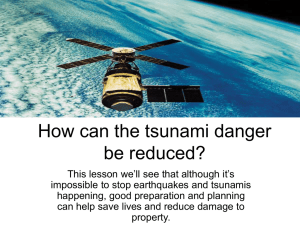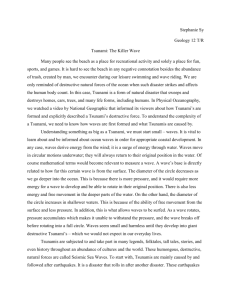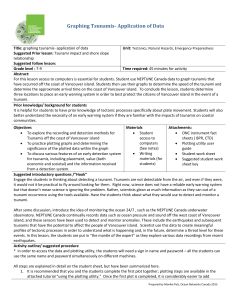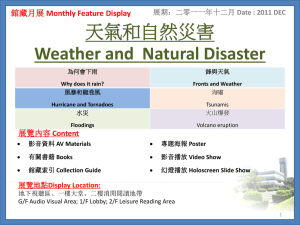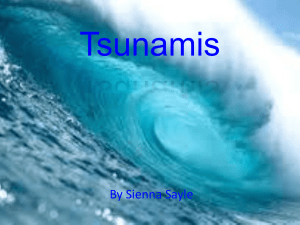File
advertisement
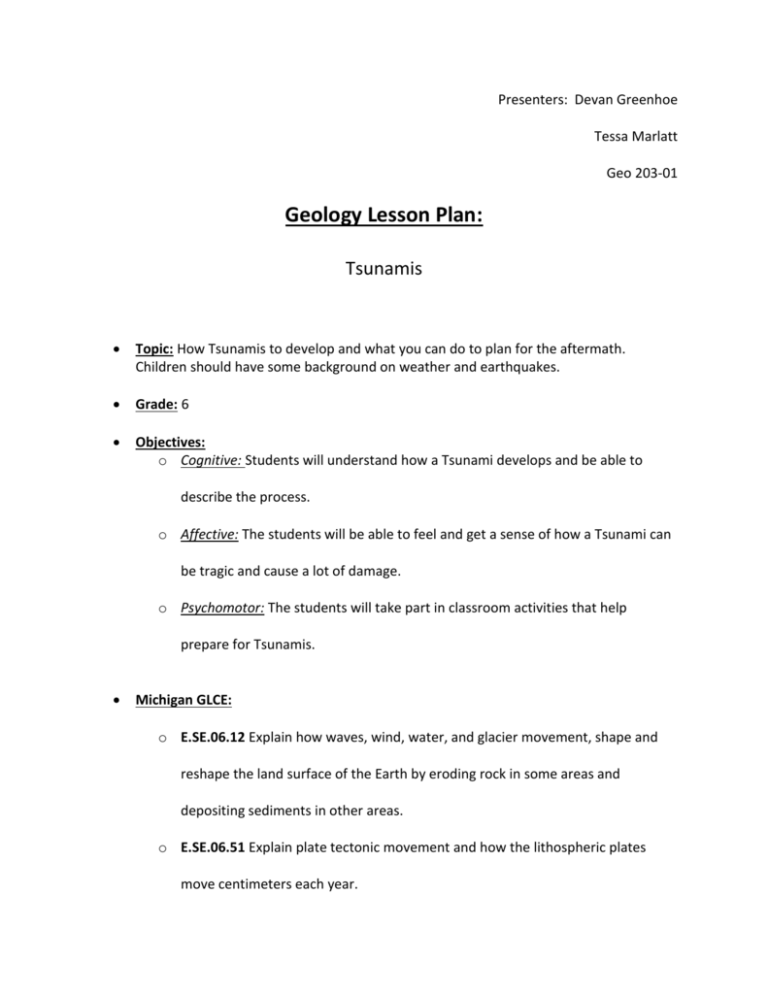
Presenters: Devan Greenhoe Tessa Marlatt Geo 203-01 Geology Lesson Plan: Tsunamis Topic: How Tsunamis to develop and what you can do to plan for the aftermath. Children should have some background on weather and earthquakes. Grade: 6 Objectives: o Cognitive: Students will understand how a Tsunami develops and be able to describe the process. o Affective: The students will be able to feel and get a sense of how a Tsunami can be tragic and cause a lot of damage. o Psychomotor: The students will take part in classroom activities that help prepare for Tsunamis. Michigan GLCE: o E.SE.06.12 Explain how waves, wind, water, and glacier movement, shape and reshape the land surface of the Earth by eroding rock in some areas and depositing sediments in other areas. o E.SE.06.51 Explain plate tectonic movement and how the lithospheric plates move centimeters each year. o E.SE.06.52 Demonstrate how major geological events (earthquakes, volcanic eruptions, mountain building) result from these plate motions. Materials: o Things needed to complete the activity: Tsunami Book Diagrams of Earthquakes, Volcanic Eruptions and Land Slides. Plastic bags Bottled water Granola Bars Band Aids Neosporin Ace wrap Emergency Flares Gauze pads Flash light Five “E”: o Engage: We intend to engage the student’s attention by either showing them an animated video of tsunamis or start our lesson of by introducing our book. By doing these we hope that the students will be interested in the topic on tsunamis and want to continue to learn more. We will then continue to create the desire for the students want to learn more about the topic by discussing the dangers of tsunamis. o Explore: This activity will take place after the students have learned about earthquakes and volcanoes. The students will be doing a couple activities such as putting together a disaster kit, and making the representations of how the tsunamis can be caused. All these activities will be hands on and will allow the students to get a better representation of how tsunamis occur and what you need to survive such disaster. These activities will be inquiry based because we will be guiding the students to accomplish the tasks. We will do this by asking them questions about each activity. For example when we are discussing the causes of the tsunamis we will ask the students why they think they three situations cause tsunamis. We will continue asking questions as we further explore each cause. When we start putting together our disaster kit we would ask the students why they think they are important after the disaster and what they think should include in the disaster kits. o Explain: Using the disaster kit activity and a collection of the students prior knowledge as a starting point, the explain phase will go over the causes of tsunamis and where they occur most often. . A tsunami is a large ocean wave that is caused by sudden motion on the ocean floor. This sudden motion could be an earthquake, a powerful volcanic eruption, or an underwater landslide. The impact of a large meteorite could also cause a tsunami. Tsunamis travel across the open ocean at great speeds and build into large deadly waves in the shallow water of a shoreline. A tsunami is a series of waves, made in an ocean or other body of water by an earthquake, landslide, volcanic eruption, or meteorite impact. Tsunamis can cause huge destruction when they hit coastlines. Some people call tsunamis “tidal waves”, but these large waves really have little to do with tides, so the term “tidal wave” does not really suit them. Tsunami waves are huge and can travel very quickly, at about 700 km/hr, but they are only about one meter high in the open ocean. As a tsunami wave travels into the shallower water near the coast, it slows and grows in height. Even though a tsunami may be barely visible at sea, it may grow to be many meters high near the coast and have a tremendous amount of energy. When it finally reaches the coast, a tsunami may appear as a rapidly rising or falling tide or a series of waves with a maximum height of up to 30 meters. o Elaborate: To elaborate further on the students knowledge of tsunamis, we will have a few discussion questions A tsunami can cause a lot of damage very quickly. Sometimes people have little time to escape before their houses get flooded. Have you ever been in a flood or do you know someone who has? How much time do people have to escape from a flood? What can they take with them? Where could people go to be safe from the rising floodwaters? If a family's home gets flooded, should they move back to the same place after the water goes down or choose a new place to live? o Evaluate: To evaluate the student’s new knowledge of tsunamis, we will have them research the most recent tsunami in Japan. The students will first think of questions that they think are important to know about the tsunami from what we have learned and then they research and answer their questions. At the very end of the lesson the students will also take a short quiz. Steps of Lesson: o Begin the lesson by reading the book Tsunami. (10-15 minutes) After reading the book ask the students some key questions about the book. Ask the students if they know how Tsunamis occur and if they can explain it to the class. o Discuss disaster kits and how they are important during natural disasters and why we would need one during and after a Tsunami. (20-25 minutes) Pass out all of the supplies for the disaster kits Ask the students why they think these supplies are important and what else they could add to their disaster kit. Have the students assemble the kits for them to take home. o Show a short video of a Tsunami so that they students can see the actual effects and why they would need their disaster kits. (5-10 minutes) o After introducing the lesson of Tsunamis begin presenting the students with information on how Tsunamis occur. (15-20 minutes) Information covered: Earthquakes Volcanic Eruptions Landslides under sea Ask the students why they think these three natural disasters cause Tsunamis. o Have discussion about floods (10 minutes) Ask questions as listed above o Research the most recent tsunami in Japan (30-45 minutes) Have the students come up with their questions. Answer questions and research the tsunami. o Give a short quiz Have fill in the blank diagrams This will show that the students understand the material they were presented at the beginning of class. Curriculum Integrated: o History: Have the students go to a computer lab (if not available assign as homework) and research the past Tsunamis that have occurred. Have them pick 2-3 Tsunamis that occurred years between and then write a report about the occurrences and how they were similar and different. With the time differences they should compare and contrast the Tsunamis’. o Art: Have the students draw, paint, or build the cause of a Tsunami and then label the pictures (diagrams). This can be used as a study guide and visual aid for better understanding for the students. o ELA: When the students are thinking about their questions regarding the tsunami in Japan and when they are writing their report on the history of tsunamis they are incorporating English/Language Arts.
